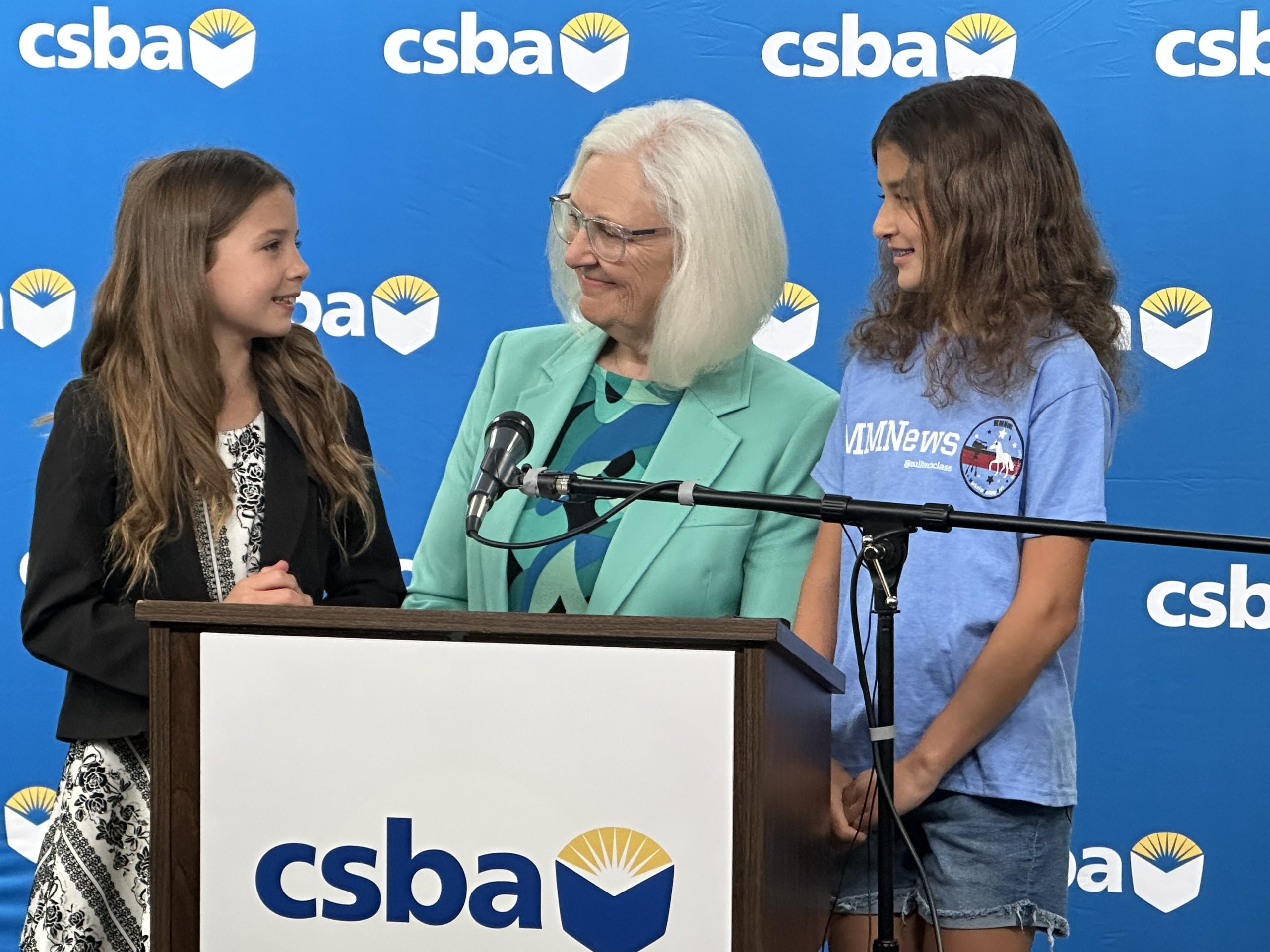By Susan Markarian
A few weeks ago, I had the privilege of speaking at a press conference in support of Assembly Bill 1023 (Papan, D-San Mateo), a CSBA-sponsored bill that will help protect schools from cyberattacks and data theft. The media was well represented at the press conference, with all the local affiliates of the major television networks in attendance. Yet, it wasn’t the professional media that left the strongest impression. Instead, it was the student journalists from our host school, Florence Markofer Elementary in Elk Grove Unified School District.
One of the best parts of serving as CSBA President is the opportunity it presents to visit schools and see the magical things that are taking place on campus and in our classrooms around the state. Markofer’s media program is a perfect example of why I cherish these visits. The sixth-grade student journalists who kicked off the press conference and interviewed me afterward had poise beyond their years and the ideal setting to hone their skills.
Markofer students have access to a wonderful facility with a computer lab, a full multimedia production studio, 3D printers and the guidance of a computer resource teacher who has gone above and beyond to secure grants and personally provide the resources and training her young scholars need. Most high schools would be envious of the program at Markofer Elementary, and justifiably so. The environment and opportunity they’ve created for their students at an early age should be the standard for all California public school students.
It is so important for our students to experience education that develops skills and gives them an opportunity to explore potential careers. The benefits of career technical education (CTE) are vast and far-reaching. CTE programs integrate academic knowledge with practical, hands-on training, enabling students to apply their learning directly to real-world scenarios. By doing so, they foster critical-thinking, problem-solving and creativity — skills that are in high demand across industries. Moreover, CTE cultivates essential technical skills, such as coding, robotics, healthcare, construction and culinary arts, ensuring that students are well-prepared for emerging industries and occupations.
In today’s rapidly evolving job market, it is crucial that we equip our students with the skills and knowledge needed to thrive in the 21st-century workforce. Research consistently supports the positive impact of CTE. According to a study by the Association for Career and Technical Education, students engaged in CTE are more likely to graduate from high school, enroll in postsecondary education and secure higher-paying jobs. Additionally, the study found that CTE participants display higher levels of engagement, motivation and satisfaction with their educational experience.
While traditional academic education has long been the focus of our public schools, there is immense value in strong vocational and CTE programs. By embracing CTE, we can offer students a dynamic and comprehensive education that prepares them for success in both college and career pathways. And the earlier students take advantage of career education — like the students working the cameras, the lights and the soundboard at Markofer Elementary — the greater the benefits.
Starting CTE programs in middle school or even elementary school allows young learners to explore a wide range of career options, discover their passions and make informed decisions about their educational and professional paths. For all these reasons, equitable access to CTE must be a priority. It is crucial to recognize that CTE is not only an alternative for students who struggle academically, but rather a complementary pathway that caters to a range of learning styles, interests and aspirations. With that in mind, governance teams should work to dismantle any barriers that hinder equitable access, such as funding disparities, limited course offerings and stigmas surrounding CTE. By providing every student with the chance to explore and engage in career-oriented education, we can promote social mobility and reduce achievement gaps. While CTE will look different in every local educational agency, there are several key steps governance teams can take to implement and improve career education:
- Collaborate with local businesses and industries: Forge partnerships to develop relevant and up-to-date curriculum that aligns with workforce needs. Engage employers in mentoring, internship and apprenticeship opportunities.
- Invest in professional development: Provide ongoing training and support for CTE teachers to ensure they have the expertise to deliver high-quality instruction and maintain industry relevance.
- Expand program offerings: Increase the variety of CTE pathways available to students, encompassing a wide range of industries, from healthcare and information technology to skilled trades and entrepreneurship.
- Establish clear pathways and articulation agreements: Develop seamless transitions between CTE programs in high school, community colleges, and four-year institutions, enabling students to pursue further education and advanced degrees.
- Enhance career counseling and guidance: Bolster resources to help students navigate the various CTE options, make informed decisions, and develop personalized career plans.
- Promote community engagement: Organize career fairs, industry showcases and mentorship programs that connect students with professionals, creating networking opportunities and fostering real-world connections.
- Monitor and evaluate program outcomes: Continuously assess the effectiveness and impact of CTE programs through data collection, student performance tracking, and feedback mechanisms.
By embracing career technical education statewide, we can open doors for so many students and better prepare them for the challenges of our ever-evolving workforce and constantly changing society.
Susan Markarian is CSBA President.
Image courtesy of the Bob Hoover Academy at the Monterey County Office of Education






